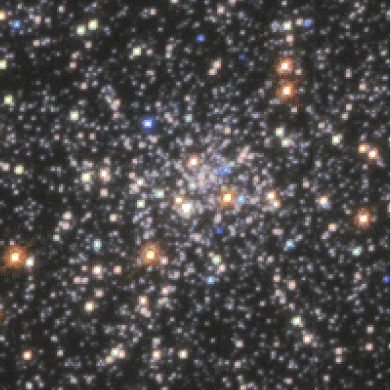
 The absolute brightness or luminosity is one means of distinguishing
between stars. However, two stars of the same absolute brightness are
not necessarily identical in every other aspect. One other feature of
stars which is useful in their classification is their color or
spectral type. Every gas has a distinctive fingerprint depending on
its temperature. A hot gas will emit radiation and the collection of
elements that make up the gas will result in different wavelengths
(colors) of radiation being detected. Hot stars are typically blue
in color while cool stars are red. A classic example of this is
that of sodium street lamps. A lamp filled with sodium gas has a
distinctive yellow color while an argon lamp, for example, is
typically red. By identifying the characteristic colors emitted
by a star, it is possible to determine which elements make up the gas
and what the temperature of the gas is. These stellar fingerprints
(spectra) are determined using an instrument called a spectrometer,
attached to a normal optical telescope. A simple example of a
spectrometer is a prism which splits light up into a ``spectrum'' of
colors. The spectrum of a star rather than its luminosity is what is used to
classify it. Because of the relationship between spectral type and
how hot the stellar surface is, we can characterize a
star by its temperature. The Sun has a surface temperature of
5,800 degrees centigrade. The dominant color of the Sun's radiation is yellow and is
therefore considered as a yellow star.
The absolute brightness or luminosity is one means of distinguishing
between stars. However, two stars of the same absolute brightness are
not necessarily identical in every other aspect. One other feature of
stars which is useful in their classification is their color or
spectral type. Every gas has a distinctive fingerprint depending on
its temperature. A hot gas will emit radiation and the collection of
elements that make up the gas will result in different wavelengths
(colors) of radiation being detected. Hot stars are typically blue
in color while cool stars are red. A classic example of this is
that of sodium street lamps. A lamp filled with sodium gas has a
distinctive yellow color while an argon lamp, for example, is
typically red. By identifying the characteristic colors emitted
by a star, it is possible to determine which elements make up the gas
and what the temperature of the gas is. These stellar fingerprints
(spectra) are determined using an instrument called a spectrometer,
attached to a normal optical telescope. A simple example of a
spectrometer is a prism which splits light up into a ``spectrum'' of
colors. The spectrum of a star rather than its luminosity is what is used to
classify it. Because of the relationship between spectral type and
how hot the stellar surface is, we can characterize a
star by its temperature. The Sun has a surface temperature of
5,800 degrees centigrade. The dominant color of the Sun's radiation is yellow and is
therefore considered as a yellow star.
